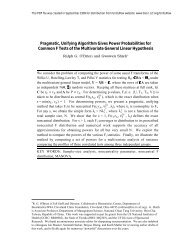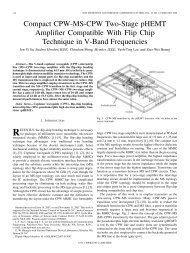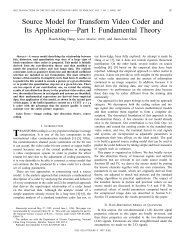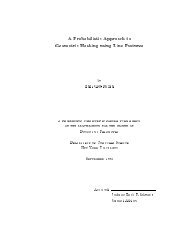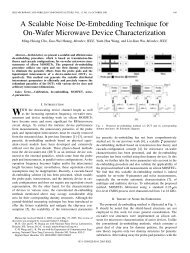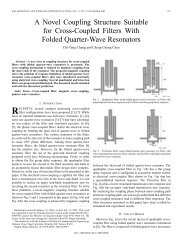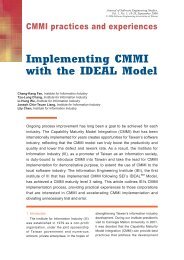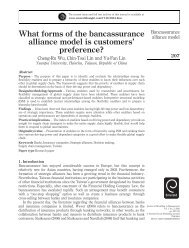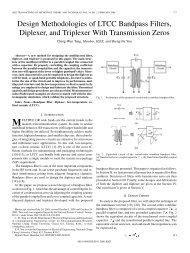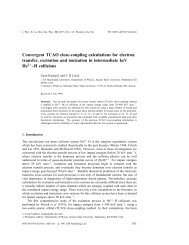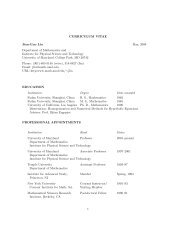Nonlinear dynamics induced by external optical injection in ...
Nonlinear dynamics induced by external optical injection in ...
Nonlinear dynamics induced by external optical injection in ...
You also want an ePaper? Increase the reach of your titles
YUMPU automatically turns print PDFs into web optimized ePapers that Google loves.
774 T B Simpson et al<br />
spectrum follows the progression to period doubl<strong>in</strong>g, figure 5(e) with ξ 2 = 6 × 10 −3 ,<br />
and to limit cycle oscillations, figure 5(f ) with ξ 2 = 1.2 × 10 −2 . The frequency push<strong>in</strong>g<br />
cont<strong>in</strong>ues to <strong>in</strong>crease and the pushed feature gets relatively weaker. At very high <strong><strong>in</strong>jection</strong><br />
levels, ξ 2 > 3–4 × 10 −2 , the laser output beg<strong>in</strong>s to smoothly shift to other longitud<strong>in</strong>al<br />
modes.<br />
Us<strong>in</strong>g spectra like those of figures 4 and 5, we have constructed a mapp<strong>in</strong>g of the<br />
<strong>dynamics</strong> for the laser at this pump level as the <strong><strong>in</strong>jection</strong> parameter and the frequency<br />
offset are varied. In the mapp<strong>in</strong>g of figure 6, the frequency axis is relative to the freerunn<strong>in</strong>g<br />
frequency of the <strong>in</strong>jected laser. The symbols used are: 4, a perturbation spectrum<br />
with weak regenerative amplification and four-wave mix<strong>in</strong>g sidebands; S, stable <strong><strong>in</strong>jection</strong><br />
lock<strong>in</strong>g; SR, subharmonic resonance; P1, limit-cycle oscillation; P2, period doubl<strong>in</strong>g; P4,<br />
period quadrupl<strong>in</strong>g; chaos, determ<strong>in</strong>istic chaos; M ′ , multiwave mix<strong>in</strong>g with most output<br />
on another longitud<strong>in</strong>al mode; hatched regions, pr<strong>in</strong>cipal output on another longitud<strong>in</strong>al<br />
mode; th<strong>in</strong> curves, smooth transition between dynamic regions; thick dotted curves, abrupt<br />
mode-hop transitions with m<strong>in</strong>or hysteresis; thick broken curves with an arrow, oneway<br />
mode hops out of mode; thick full curves, abrupt transition to/from a region of<br />
chaos or multiwave mix<strong>in</strong>g where there is significant power <strong>in</strong> another longitud<strong>in</strong>al mode,<br />
from/to a region with power primarily <strong>in</strong> the pr<strong>in</strong>cipal mode. The smooth transitions<br />
represented <strong>by</strong> the th<strong>in</strong> curves are approximate. For <strong>in</strong>stance, a peak-to-sideband ratio<br />
of 10:1 was used for the transition l<strong>in</strong>e from stable to unstable <strong>dynamics</strong>. For small values<br />
of ξ, the <strong>optical</strong> <strong><strong>in</strong>jection</strong> acts as a perturbation generat<strong>in</strong>g weak sidebands at the offset<br />
frequency, regenerative amplification and equally and oppositely shifted four-wave mix<strong>in</strong>g.<br />
Figure 6. Mapp<strong>in</strong>g of the experimentally observed dynamic regions for a conventional edgeemitt<strong>in</strong>g<br />
semiconductor laser with J ˜ = 2 3 . The <strong>dynamics</strong> are determ<strong>in</strong>ed <strong>by</strong> comparison of<br />
observed spectra with calculated spectra with and without noise. The symbols are def<strong>in</strong>ed <strong>in</strong> the<br />
text.




